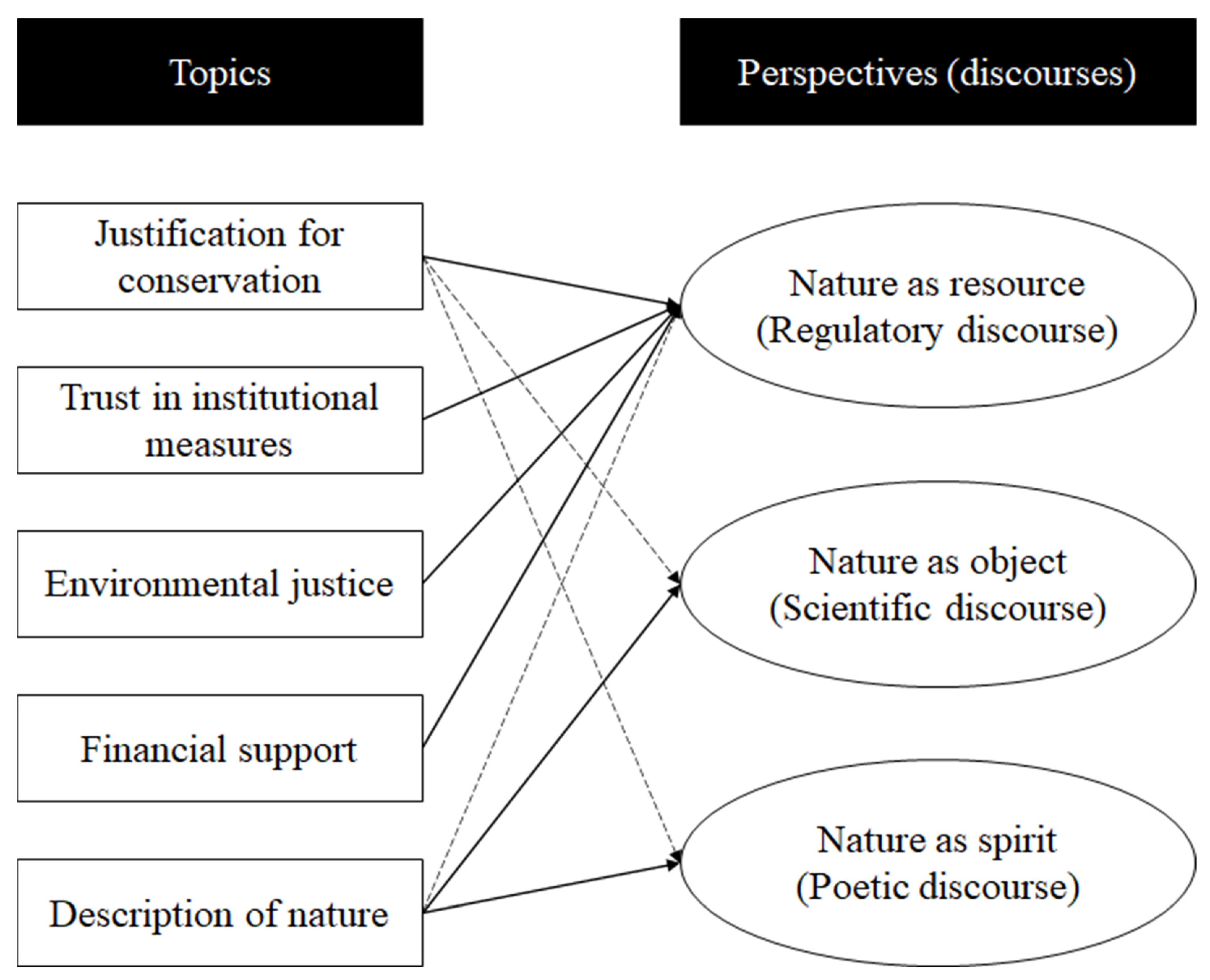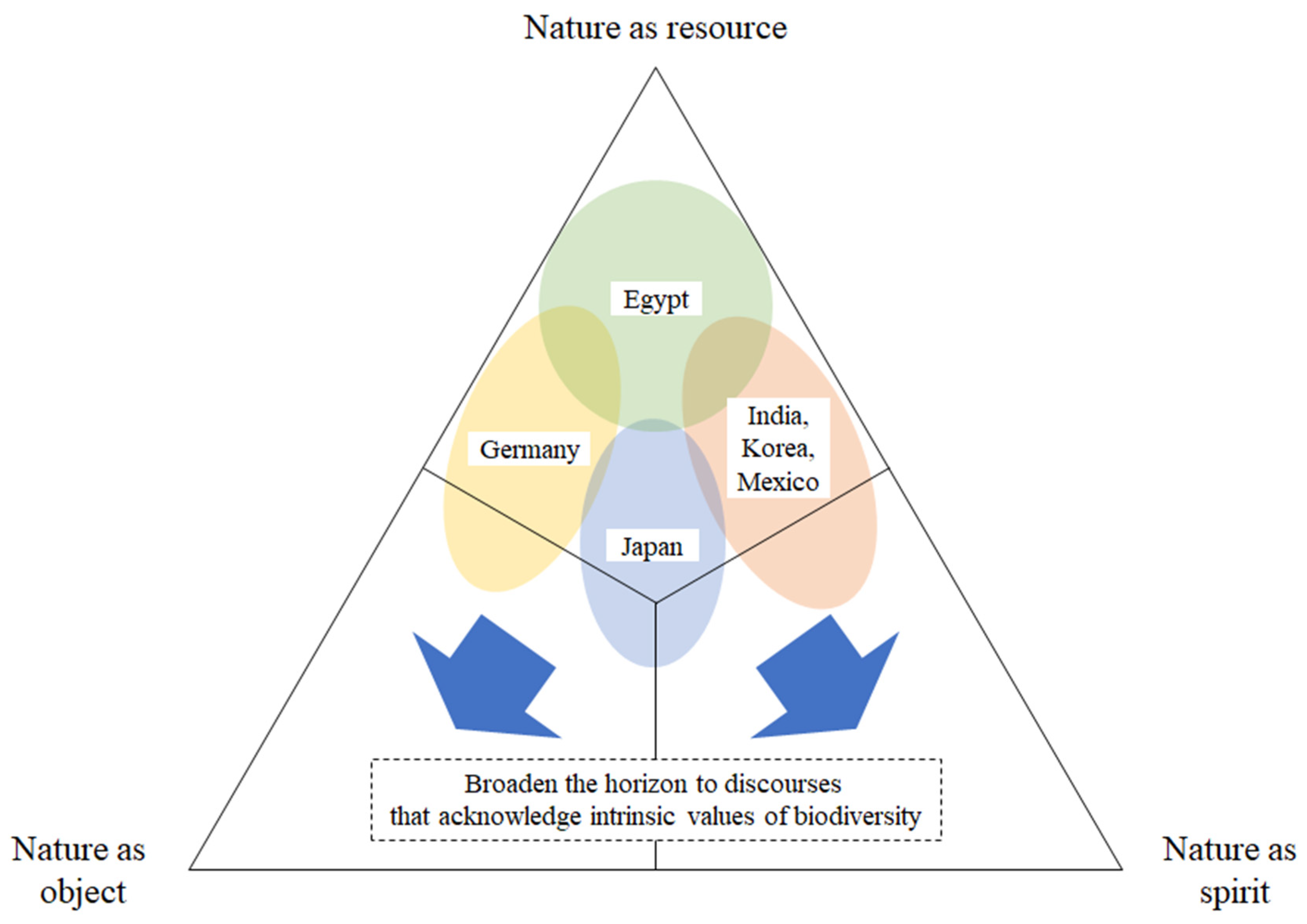Toward a More Expansive Discourse in a Changing World: An Analysis of Political Leaders’ Speeches on Biodiversity
Abstract
1. Introduction
2. Materials and Methods
3. Results
3.1. Justification for Conservation
3.2. Trust in Institutional Measures
3.3. Environmental Justice
3.4. Financial Support
3.5. Description of Nature
4. Discussion
Author Contributions
Funding
Acknowledgments
Conflicts of Interest
References
- Convention on Biological Diversity. Decision Adopted by the Conference of the Parties to the Convention on Biological Diversity at Its First Meeting: I/1. Rules of Procedure for the Conference of the Parties; Convention on Biological Diversity: Nassau, Bahamas, 1994. [Google Scholar]
- Convention on Biological Diversity. Decision adopted by the Conference of the Parties to the Convention on Biological Diversity at its fifth meeting: V/20. Operations of the Convention; Convention on Biological Diversity: Nairobi, Kenya, 2000. [Google Scholar]
- Herkenrath, P.; Harrison, J. The 10th meeting of the Conference of the Parties to the Convention on Biological Diversity-a breakthrough for biodiversity? Oryx 2011, 45, 1–2. [Google Scholar] [CrossRef]
- Hajer, M.; Versteeg, W. A decade of discourse analysis of environmental politics: Achievements, challenges, perspectives. J. Environ. Policy Plan. 2005, 7, 175–184. [Google Scholar] [CrossRef]
- Hannigan, J. Environmental Sociology, 2nd ed.; Routledge: London, UK; New York, NY, USA, 2006; ISBN 9780415355124. [Google Scholar]
- Fischer, F. Reframing Public Policy: Discursive Politics and Deliberative Practices; Oxford University Press: Oxford, UK, 2003; ISBN 9780199242641. [Google Scholar]
- Hajer, M. Discourse Coalitions and the Institutionalization of Practice: The Case of Acid Rain in Britain. In The Argumentative Turn in Policy Analysis and Planning; Fischer, F., Forester, J., Eds.; UCL: London, UK, 1993; pp. 43–76. [Google Scholar]
- Feindt, P.H.; Oels, A. Does discourse matter? Discourse analysis in environmental policy making. J. Environ. Policy Plan. 2005, 7, 161–173. [Google Scholar] [CrossRef]
- Leipold, S.; Feindt, P.H.; Winkel, G.; Keller, R. Discourse analysis of environmental policy revisited: Traditions, trends, perspectives. J. Environ. Policy Plan. 2019, 21, 445–463. [Google Scholar] [CrossRef]
- Hussein, H. Yarmouk, Jordan, and Disi basins: Examining the impact of the discourse of water scarcity in Jordan on transboundary water governance. Mediterr. Polit. 2019, 24, 269–289. [Google Scholar] [CrossRef]
- Hussein, H. A critique of water scarcity discourses in educational policy and textbooks in Jordan. J. Environ. Educ. 2018, 49, 260–271. [Google Scholar] [CrossRef]
- Väliverronen, E. Biodiversity and the Power of Metaphor in Environmental Discourse. Sci. Stud. (St. Bonaventure) 1998, 11, 19–34. [Google Scholar]
- Escobar, A. Whose Knowledge, Whose nature? Biodiversity, Conservation, and the Political Ecology of Social Movements. J. Polit. Ecol. 1998, 5, 53. [Google Scholar] [CrossRef]
- Turnhout, E.; Waterton, C.; Neves, K.; Buizer, M. Rethinking biodiversity: From goods and services to “living with”. Conserv. Lett. 2013, 6, 154–161. [Google Scholar] [CrossRef]
- Carmen, E.; Watt, A.; Young, J. Arguing for biodiversity in practice: A case study from the UK. Biodivers. Conserv. 2018, 27, 1599–1617. [Google Scholar] [CrossRef]
- Espinosa, C. Interpretive Affinities: The Constitutionalization of Rights of Nature, Pacha Mama, in Ecuador. J. Environ. Policy Plan. 2019, 21, 608–622. [Google Scholar] [CrossRef]
- Durand, L.; Vázquez, L.B. Biodiversity conservation discourses. A case study on scientists and government authorities in Sierra de Huautla Biosphere Reserve, Mexico. Land Use Policy 2011, 28, 76–82. [Google Scholar] [CrossRef]
- Herndl, C.G.; Brown, S.C. Introduction. In Green Culture: Environmental Rhetoric in Contemporary America; Herndl, C.G., Brown, S.C., Eds.; University of Wisconsin Press: Madison, WI, USA, 1996; pp. 3–20. [Google Scholar]
- Marafiote, T.; Plec, E. From dualisms to dialogism: Hybridity in discourse about the natural world. In The Environmental Communication Yearbook, 3rd ed.; Depoe, S.P., Ed.; Routledge: New York, NY, USA, 2006; pp. 49–75. [Google Scholar]
- Gustafsson, K.M. Environmental discourses and biodiversity: The construction of a storyline in understanding and managing an environmental issue. J. Integr. Environ. Sci. 2013, 10, 39–54. [Google Scholar] [CrossRef]
- Schlenz, M. Greening “Gray Literature”: Rhetorical Models for Environmental Discourses. In Technical Communication, Deliberative Rhetoric, and Environmental Discourse: Connections and Directions; Coppola, N., Coppola, N.W., Karis, B., Eds.; ATTW Contemporary Studies in Technical Communication; Ablex Publishing Corporation: Stamford, CT, USA, 2000; ISBN 9781567504804. [Google Scholar]
- Dryzek, J.S. The Politics of the Earth: Environmental Discourses; Oxford University Press: Oxford, UK; New York, NY, USA, 2005; ISBN 9780199277391. [Google Scholar]
- Brulle, R.J. Environmental Discourse and Social Movement Organizations: A Historical and Rhetorical Perspective on the Development of U.S. Environmental Organizations. Sociol. Inq. 1996, 66, 58–83. [Google Scholar] [CrossRef]
- Merchant, C. The Death of Nature: Women, Ecology, and the Scientific Revolution; G—Reference, Information and Interdisciplinary Subjects Series; HarperCollins: New York, NY, USA, 1990; ISBN 9780062505958. [Google Scholar]
- van Koppen, C.S.A. Resource, Arcadia, Lifeworld. Nature Concepts in Environmental Sociology. Sociol. Rural. 2000, 40, 300–318. [Google Scholar] [CrossRef]
- MacDonald, K.I. The devil is in the (bio)diversity: Private sector “engagement” and the restructuring of biodiversity conservation. Antipode 2010, 42, 513–550. [Google Scholar] [CrossRef]
- Spash, C.L.; Aslaksen, I. Re-establishing an ecological discourse in the policy debate over how to value ecosystems and biodiversity. J. Environ. Manag. 2015, 159, 245–253. [Google Scholar] [CrossRef] [PubMed]
- Gavin, M.; McCarter, J.; Berkes, F.; Mead, A.; Sterling, E.; Tang, R.; Turner, N. Effective Biodiversity Conservation Requires Dynamic, Pluralistic, Partnership-Based Approaches. Sustainability 2018, 10, 1846. [Google Scholar] [CrossRef]
- Hannigan, J.A. Environmental Sociology: A Social Constructionist Perspective; Environment and society; Routledge: London, UK, 1995; ISBN 9780415112550. [Google Scholar]
- Wilson, E.O. Half-Earth: Our Planet’s Fight for Life; Norton & Company: New York, NY, USA, 2016. [Google Scholar]
- Convention on Biological Diversity. Report of the Conference of the Parties to the Convention on Biological Diversity on its Thirteenth Meeting; Convention on Biological Diversity: Cancun, Mexico, 2016. [Google Scholar]
- Cabinet of Egypt The Prime Minister’s Speech at the Opening of the Ministerial Meeting of the Fourteenth Conference of Parties to the Convention on Biological Diversity. Available online: http://www.cabinet.gov.eg/arabic/PrimeMinister/SpeechesInterviews/ (accessed on 20 January 2020).
- Chung, H. The Message at the Opening Ceremony of the 12th Conference of Parties to the CBD. Available online: http://www.opm.go.kr/opm/prime/past-speech.do?mode=view&articleNo=9747 (accessed on 28 December 2019).
- Kan, N. Address by H.E. Mr. Naoto Kan Prime Minister of Japan at the Opening of the High Level Segment of the Tenth Meeting of the Conference of Parties to the Convention on Biological Diversity. Available online: https://japan.kantei.go.jp/kan/statement/201010/27speech_e.html (accessed on 31 July 2020).
- Merkel, A. Rede von Bundeskanzlerin Dr. Angela Merkel. Available online: https://www.bundesregierung.de/breg-de/service/bulletin/rede-von-bundeskanzlerin-dr-angela-merkel-796140 (accessed on 27 May 2020).
- Secretariat of Environment and Natural Resources. United Nations Biodiversity Conference Presidency Report Mexico 2016–2018; Secretariat of Environment and Natural Resources: Mexico City, Mexico, 2018. [Google Scholar]
- Singh, M. Remarks by the Prime Minister at the inauguration of the High Level Segment of the 11th Conference of Parties to the Convention on Biological Diversity. Available online: https://www.cbd.int/doc/speech/2012/sp-2012-10-16-cop11-hls-in-pm-en.pdf (accessed on 31 July 2020).
- Babbie, E. The Practice of Social Research; Cengage Learning: Belmont, CA, USA, 2009; ISBN 9780495598411. [Google Scholar]
- Beretta, I. Some Highlights on the Concept of Environmental Justice and its Use. e-Cad. CES 2012, 136–162. [Google Scholar] [CrossRef]
- Environment Protection Agency. Guidance for Incorporating Environmental Justice Concerns in EPA’s NEPA Compliance Analyses; Environment Protection Agency: Washington, DC, USA, 1998.
- Dunlap, R.E.; Jorgenson, A.K. Environmental problems. Wiley-Blackwell Encycl. Glob. 2012, 2, 519–540. [Google Scholar] [CrossRef]
- Speth, J.G.; Haas, P.M. Global Environmental Governance; Island Press: Washington, DC, USA, 2006. [Google Scholar]
- World Commission on Environment and Development. Our Common Future; Oxford University Press: Oxford, UK, 1987. [Google Scholar]
- American Veterinary Medical Association. One health: A new professional imperative. In One Health Initiative Task Force: Final Report; American Medical Veterinary Association: Schaumburg, IL, USA, 2008; pp. 1–71. [Google Scholar]
- Romanelli, C.; Cooper, H.D.; De Souza Dias, B.F. The integration of biodiversity into One Health. OIE Rev. Sci. Tech. 2014, 33, 487–496. [Google Scholar] [CrossRef]
- Anthwal, A.; Gupta, N.; Sharma, A.; Anthwal, S.; Kim, K.H. Conserving biodiversity through traditional beliefs in sacred groves in Uttarakhand Himalaya, India. Resour. Conserv. Recycl. 2010, 54, 962–971. [Google Scholar] [CrossRef]
- Virtanen, P. The Role of Customary Institutions in the Conservation of Biodiversity: Sacred Forests in Mozambique. Environ. Values 2016, 11, 227–241. [Google Scholar] [CrossRef]
- Yang, R.; Peng, Q.; Cao, Y.; Zhong, L.; Hou, S.; Zhao, Z.; Huang, C. Transformative changes and paths toward biodiversity conservation in China. Biodivers. Sci. 2019, 27, 1032–1040. [Google Scholar] [CrossRef]
- Zou, Y.; Fu, Y.; Yang, L.; Wan, X.; Wang, Y.; Liu, J. China and COP 15: A path for responsible environmental power. Biodivers. Sci. 2017, 25, 1169–1175. [Google Scholar] [CrossRef][Green Version]
- Pearson, R.M.; Sievers, M.; McClure, E.C.; Turschwell, M.P.; Connolly, R.M. COVID-19 recovery can benefit biodiversity. Science 2020, 368, 838–839. [Google Scholar] [PubMed]


| Category | COP-9 (Germany) | COP-10 (Japan) | COP-11 (India) | COP-12 (Korea) | COP-13 (Mexico) | COP-14 (Egypt) |
|---|---|---|---|---|---|---|
| Justification for conservation |
|
|
|
|
|
|
| Trust in institutions |
|
|
|
|
|
|
| Financial support |
|
|
|
| ||
| Environmental justice |
|
|
|
|
|
|
| Description of nature |
|
|
|
|
|
Publisher’s Note: MDPI stays neutral with regard to jurisdictional claims in published maps and institutional affiliations. |
© 2021 by the authors. Licensee MDPI, Basel, Switzerland. This article is an open access article distributed under the terms and conditions of the Creative Commons Attribution (CC BY) license (http://creativecommons.org/licenses/by/4.0/).
Share and Cite
Lee, S.H.; Kang, Y.H.; Dai, R. Toward a More Expansive Discourse in a Changing World: An Analysis of Political Leaders’ Speeches on Biodiversity. Sustainability 2021, 13, 2899. https://doi.org/10.3390/su13052899
Lee SH, Kang YH, Dai R. Toward a More Expansive Discourse in a Changing World: An Analysis of Political Leaders’ Speeches on Biodiversity. Sustainability. 2021; 13(5):2899. https://doi.org/10.3390/su13052899
Chicago/Turabian StyleLee, Sang Hun, Yi Hyun Kang, and Rong Dai. 2021. "Toward a More Expansive Discourse in a Changing World: An Analysis of Political Leaders’ Speeches on Biodiversity" Sustainability 13, no. 5: 2899. https://doi.org/10.3390/su13052899
APA StyleLee, S. H., Kang, Y. H., & Dai, R. (2021). Toward a More Expansive Discourse in a Changing World: An Analysis of Political Leaders’ Speeches on Biodiversity. Sustainability, 13(5), 2899. https://doi.org/10.3390/su13052899






